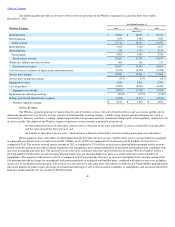Sprint - Nextel 2012 Annual Report Download - page 42
Download and view the complete annual report
Please find page 42 of the 2012 Sprint - Nextel annual report below. You can navigate through the pages in the report by either clicking on the pages listed below, or by using the keyword search tool below to find specific information within the annual report.
Table of Contents
Income Tax Expense
The consolidated effective tax rate was an expense of approximately 4%
,
10%
and 5% in
2012, 2011
, and
2010
, respectively. The income tax
expense for
2012, 2011
, and
2010
is primarily attributable to taxable temporary differences from amortization of FCC licenses and includes a
$1.8 billion
,
$1.2 billion
, and
$1.4 billion
net increase to the valuation allowance for federal and state deferred tax assets primarily related to net operating loss
carryforwards generated during the respective periods. The income tax expense for
2012
also includes a
$69 million
tax benefit resulting from the
resolution of various federal and state income tax uncertainties. The income tax expense for
2011
also includes a $59 million expense resulting from
changes in corporate state income tax laws. We do not expect to record significant tax benefits on future net operating losses until our circumstances
justify the recognition of such benefits. Additional information related to items impacting the effective tax rates can be found in the Notes to the
Consolidated Financial Statements.
Segment Earnings
-
Wireless
Wireless segment earnings are primarily a function of wireless service revenue, costs to acquire subscribers, network and interconnection
costs to serve those subscribers and other Wireless segment operating expenses. The costs to acquire our subscribers include the net cost at which
we sell our devices, referred to as equipment net subsidies, as well as the marketing and sales costs incurred to attract those subscribers. Network
costs primarily represent switch and cell site costs and interconnection costs, which generally consist of per
-
minute usage fees and roaming fees paid
to other carriers. The remaining costs associated with operating the Wireless segment include the costs to operate our customer care organization and
administrative support. Wireless service revenue, costs to acquire subscribers, and variable network and interconnection costs fluctuate with the
changes in our subscriber base and their related usage, but some cost elements do not fluctuate in the short term with these changes.
As shown by the table above under “Results of Operations,” Wireless segment earnings represented approximately
86%
of our total
consolidated segment earnings as of
December 31, 2012
. The wireless industry is subject to competition to retain and acquire subscribers of wireless
services. Most markets in which we operate have high rates of penetration for wireless services. Wireless carriers accordingly must attract a greater
proportion of new subscribers from competitors rather than from first time subscribers. Within the Wireless segment, postpaid wireless services
represent the most significant contributors to earnings, and are driven by the number of postpaid subscribers to our services, as well as the average
revenue per subscriber or user (ARPU). Wireless segment earnings have declined over the last several years, primarily resulting from subscriber losses
associated with our Nextel platform postpaid offerings. Most recently, our decision to shut
-
down the Nextel platform has accelerated the loss of
subscribers on that platform; however, we have focused our efforts on recapturing these subscribers on our Sprint platform. In addition, we have
taken initiatives to strengthen the Sprint brand and continue to increase market awareness of the improvements that have been achieved in the
customer experience. We have also introduced new devices, including the iPhone® in the fourth quarter of 2011 and the iPad® in the fourth quarter of
2012, improving our overall lineup and providing a competitive portfolio for customer selection, as well as competitive rate plans providing simplicity
and value, which have contributed to an increase in net equipment subsidy costs.
The Company has significantly improved net postpaid subscriber results on the Sprint platform subsequent to the first quarter 2009 as a
result of the actions taken, including the recapture of Nextel platform subscribers. In conjunction with Network Vision, the Company continues to
focus on the growth of the Sprint platform including the targeted retention of Nextel platform subscribers through competitive offerings on the Sprint
platform, which includes Sprint Direct Connect. As a result of our plans and increased competition for these subscribers, we expect that subscriber
churn on the Nextel platform, both postpaid and prepaid, will increase through the shut
-
down period of the Nextel platform. Although the Company
continues to experience net losses of Nextel platform postpaid subscribers, beginning in 2010, wireless service revenue has increased primarily as a
result of growth in subscribers from our prepaid business as well as increased postpaid ARPU and subscribers on the Sprint platform.
39
























